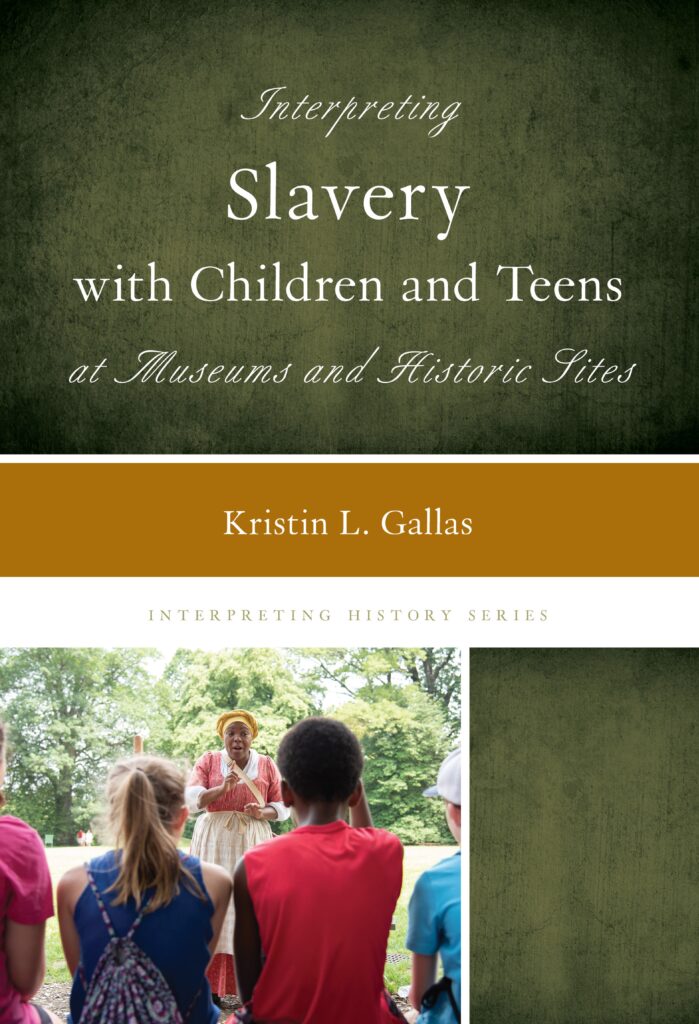Interpreting Slavery with Children and Teens at Museums and Historic Sites
Gallas’s idea, which is now this book, has the potential to transform the way the public understands American slavery. But to do so, public history professionals, when they pick up this book, have to muster the courage to implement what’s inside.
– Hasan Kwame Jeffries, Associate Professor of History at The Ohio State University
Interpreting Slavery with Children and Teens, by Kristin L. Gallas, (Rowman and Littlefield, September 2021) offers advice, examples, and replicable practices for the comprehensive development and implementation of slavery-related school and family programs at museums and historic sites. Developing successful experiences—school programs, field trips, family tours—about slavery is more than just historical research and some hands-on activities. Interpreting the history of slavery often requires offering students new historical narratives and helping them to navigate the emotions that arise when new narratives conflict with longstanding beliefs. We must talk with young people about slavery and race, as it is not enough to just talk to them or about the subject. By engaging students in dialogue about slavery and race, they bring their prior knowledge, scaffold new knowledge, and create their own relevance—all while adults hear them and show respect for what they have to say.

With a foreword by historian and educator Hasan Kwame Jeffries, Interpreting Slavery with Children and Teens pulls information from the existing literature, research from related fields, consultations with colleagues, and observations of school programs at a variety of museums and historic sites to create a framework that supports the development of comprehensive and conscientious school and family programs. The book’s framework aims to move the field forward in its collective conversation about the interpretation of slavery with young audiences, acknowledging the criticism of the past and acting in the present to develop inclusive interpretation of slavery. When an organization commits to doing school and family programs on the topic of slavery, it makes a promise to past and future generations to keep alive the memory of long-silenced millions and to raise awareness of the racist legacies of slavery in our society today. Read an excerpt of “Interpreting Slavery with Children and Teens.”
Interpreting Slavery at Museums and Historic Sites
This seminal work … will make a significant impact.
– Rex M. Ellis, Associate Director, Smithsonian National Museum of African American History and Culture
Interpreting Slavery at Museums and Historic Sites, edited by Kristin Gallas and James DeWolf Perry, was the most visible product of a three-year Tracing Center project to develop and disseminate best practices in slavery interpretation.
This project has also included surveys of the field, workshops at historic sites and museums, conference presentations and instructional sessions, as well as additional publications. The book, published by Rowman & Littlefield, is a collaboration with seven leading public historians with deep expertise in navigating the interpretation of slavery:
- Dina A. Bailey, Mountain Top Vision, LLC
- Patricia Brooks, National Endowment for the Humanities
- Richard C. Cooper, Levine Museum of the New South
- Conny Graft, Conny C. Graft Research and Evaluation (retired)
- Linnea Grim, Monticello
- Katherine D. Kane, Harriet Beecher Stowe Center (retired)
- Nicole A. Moore, National Center for Civil and Human Rights

Interpreting Slavery aims to move the field forward in its collective conversation about the interpretation of slavery—acknowledging criticism of the past and acting in the present to develop an inclusive interpretation of slavery. Presenting the history of slavery in a comprehensive and conscientious manner requires diligence and compassion—for the history itself, for those telling the story, and for those hearing the stories—but it’s a necessary part of our collective narrative about our past, present, and future.
Interpreting Slavery features best practices for:
- Interpreting slavery across the country and for diverse visitors. The history of slavery, while traditionally interpreted primarily on southern plantations, is increasingly recognized as relevant at historic sites of many kinds and across the nation. More than just an African-American and European-American story, it is relevant to the history of citizens of Latino, Caribbean, African and indigenous descent, as well, and to those descended from immigrants who arrived after slavery, whose stories are deeply intertwined with the legacy of slavery and its aftermath.
- Developing support within an institution for the interpretation of slavery. Many institutions are reticent to approach such a potentially volatile subject, so this book examines how proponents at several sites, including Monticello and Mount Vernon, were able to make a strong case to their stakeholders.
- Training interpreters in not only a depth of knowledge of the subject, but also the confidence to speak on this controversial issue in public and the compassion to handle such a sensitive historical issue and its contemporary resonances.
The book is intended primarily for professionals at all levels in the public history field, as well as students at the undergraduate and graduate levels in museum studies and public history programs. It will also be of interest to anyone teaching the history of slavery, either as an historical topic or in the context of exploring contemporary issues of race or privilege.
Interpreting Slavery at Museums and Historic Sites provides museum professionals with a roadmap to help them engage the topic with greater confidence and vision. It is thoughtful and comprehensive. Well worth the read.
– Christy Coleman, (former) president of The American Civil War Center at Historic Tredegar in Richmond, Virginia
